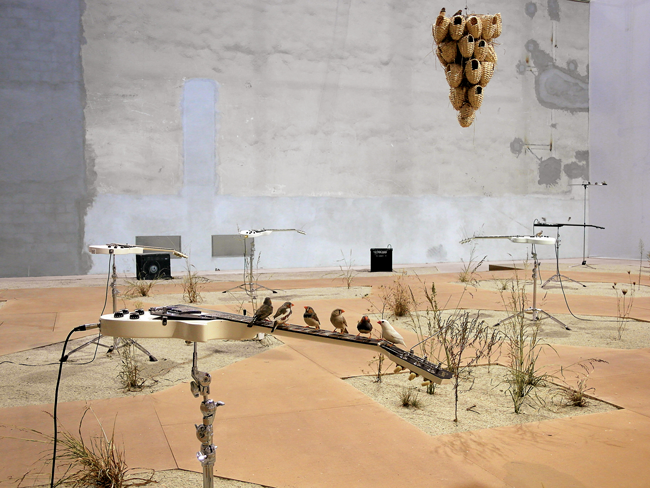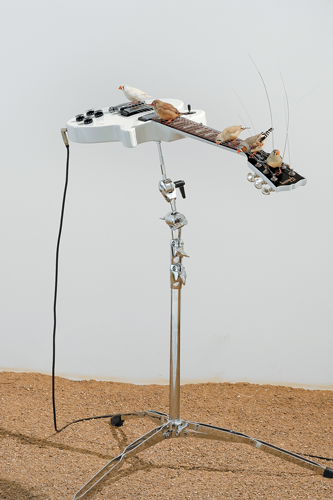Laura O’Brien
There are a lot of things that you cannot do at Céleste Boursier-Mougenot’s installation at the Montreal Museum of Fine Art: you can’t take photographs, nor touch the guitars. No touching the chain-link curtain, and—most importantly—no provoking the birds. From outside of the exhibition, deep, metallic warbles can be heard reverberating through the space. I wonder: is it really that loud inside? How could any of us possibly disturb these birds more? Following a debriefing, my curiosity is replaced with anxiety, and I enter through the heavy chain into the installation space.

Céleste Boursier-Mougenot, from here to ear (installation view), 2011. Image courtesy of the artist and Paula Cooper Gallery, New York.
The room is a softly lit, white cube. Flat walkways mimic the colour of the sand dispersed throughout the rest of the room, dictating a path of circulation throughout the installation. Fourteen Gibson guitars (ten Les Paul models and four Thunderbird bass models) jacked up to waist height, protrude from the sand among small bursts of grass, imitating the Australian grasslands to which these finches are native. Birdseed is cupped in the well of cymbals placed on the ground. Most notably, seventy plump little zebra finches animate the minimal gallery space. They bounce along the floor like popping corn, occasionally taking flight to slice through the air single-file, usually in groups of three or more. Visitors gather around individual guitars, observing the tiny manufactured ecosystem to which they are momentarily privy.
The installation has been staged nineteen times: cities such as Milan, Brisbane, Paris, London and New York have all hosted it. For each installation, the zebra finches are acquired from local breeders and aviaries—the birds in this particular installation are from Thetford Mines, Quebec. Once the exhibition has finished, they will be returned to their homes. This is not mentioned in the Montreal Museum of Fine Art website—the idea that these birds are supposedly all the way from Australia is meant to create an aura of exoticism, a problematic aim within this exhibition.

Céleste Boursier-Mougenot, from here to ear (installation view of version hors série), 2014. Image courtesy of the artist and Paula Cooper Gallery, New York. Photo by Blaise Adilon.
The birds’ visceral mechanics are rendered completely invisible in this strange aviary—the messiness of an organic body is obliterated. No shit, no mess. Just the clean white walls and manufactured topography. The finch houses are highly aestheticized: rows of symmetrical holes contained within the rigid lines of a square. Bird “condos,” that hang from the ceiling. Nesting material is sparsely intertwined in the guitar strings, evidence of the birds’ attempt at building a more suitable home. These industrious little animals use their fluorescent orange beaks to twist grass around the volume-control dials, dragging it along the smooth lacquered surface of the guitar body, attempting, in vain, to build a nest. My depressing realization is that these birds are in an ecology wherein they’ve been forced to adapt guitars as ad hoc trees.
This artwork is an exploration of sound and composition, but at what cost? From here to ear coaxes music from songbirds through movement—each time a bird lands, moves or takes off on the strings of the guitar, it emits a pre-recorded rock, punk or metal chord. The tempo of this “music” composed by the finches is affected by the movement of visitors throughout the space, and the pulsing of the finches’ wings. This is a purportedly collaborative work, between the visitor and the birds.
![Céleste Boursier-Mougenot (né en 1961) View of the installation from here to ear¬ –¬ FreePort [No. 007]: Céleste Boursier-Mougenot at the Peabody Essex Museum, Salem, Massachusetts, 2014 © Céleste Boursier-Mougenot. Courtesy of the artist and Paula Cooper Gallery, New York](http://drainmag.com/site/wp-content/uploads/2015/12/CBM-Photo2.png)
Céleste Boursier-Mougenot, from here to ear, 2014. Image courtesy of the artist and Paula Cooper Gallery, New York.
Why do we, as humans, believe that we can instrumentalize non-human animals to explore human-centric artistic inquiries? There is no empirical evidence to support that these birds are being harmed by this odd exercise. However, in interviews on CBC and Slate.com, the language used to describe the finch experience of this work is unclear: they “seem” to be enjoying the exhibition, curators “think” that the birds are capable of understanding the consequences of landing on the guitar strings. The tacit assumption that the conditions of this artwork are not disturbing for these non-human animals speaks to our enduring projection of anthropocentrism onto non-human entities. Zebra finches are songbirds: responding to the songs of other birds is a fundamental part of their maturing process. How do incessant guitar reverberations affect this? How will the zebra finches who are born into this environment be affected by this artwork? How many finches will be accidentally squashed underfoot over the course of this three-month exhibition (did Damien Hirst’s In and Out of Love teach us nothing?) With global temperatures rising to potentially deadly levels, our wholesale culling of animals for commercial purposes and the havoc we’ve wreaked on the environment writ large—all leading to the extinction of many species—it is neither the time nor the place to showcase this nonreciprocal relationship between humans and non-human animals. We have instrumentalized this relationship for far too long.
Laura O’Brien is a Masters candidate in the Art History program at Concordia University in Montreal, Quebec. Currently writing her MA thesis on feminist street art in Montreal, Laura’s interests within art history include the production of gender in space, and the analysis of material culture in cities through spatial theory, feminist theory and human geography. She is a co-director of student research group Architecture | Concordia, where she acts as an editor for the group’s forthcoming journal.